Sneezing is a powerful bodily function, especially relevant in discussions about the spread of respiratory illnesses. For years, the “safe distance” recommended by health organizations has often been around 6 feet. But is this really enough to protect us from the droplets expelled when someone sneezes? Recent research is shedding light on just how far a sneeze can travel and what measures are truly effective in minimizing the spread of germs. This article delves into a fascinating study that uses experimental visualization to explore the journey of a sneeze and the effectiveness of various face coverings.
The Science Behind a Sneeze: Simulating Real-World Conditions
To understand the dynamics of a sneeze, researchers designed an experiment that mimics the key characteristics of this forceful expulsion. Using compressed air and tracer particles, they created a pulsed jet that mirrored the turbulent nature of a sneeze. This method allowed them to visualize the sneeze and measure how far the particles traveled under different conditions.
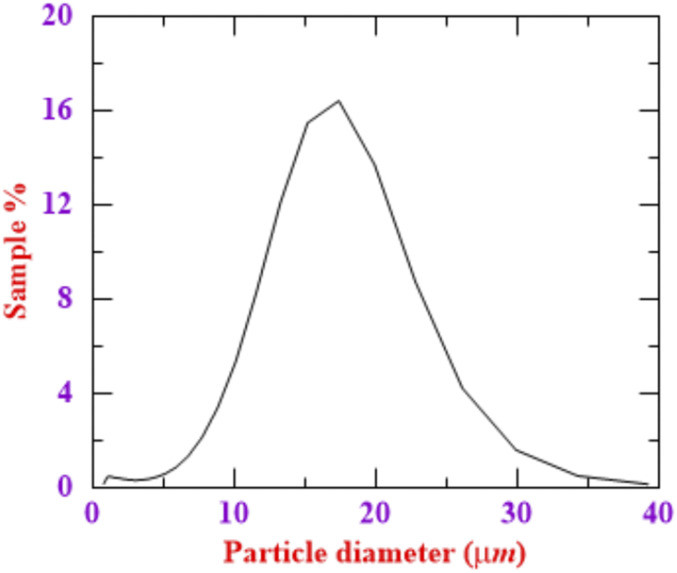 Experimental setup details
Experimental setup details
The experiment carefully considered factors like the speed and duration of a sneeze, ensuring that the simulation was dynamically similar to a real human sneeze. By using a laser and camera setup, they could track the movement of tracer particles, representing the droplets expelled during a sneeze.
Sneeze Distance: Challenging the 6-Foot Rule
The visualization revealed some eye-opening results regarding how far a sneeze can travel in a still environment. The study found that a sneeze can propel particles as far as 25 feet and take approximately 22 seconds to reach that distance. This finding immediately brings into question the widely accepted 6-foot social distancing guideline, suggesting it may be significantly underestimated, especially in the context of a sneeze.
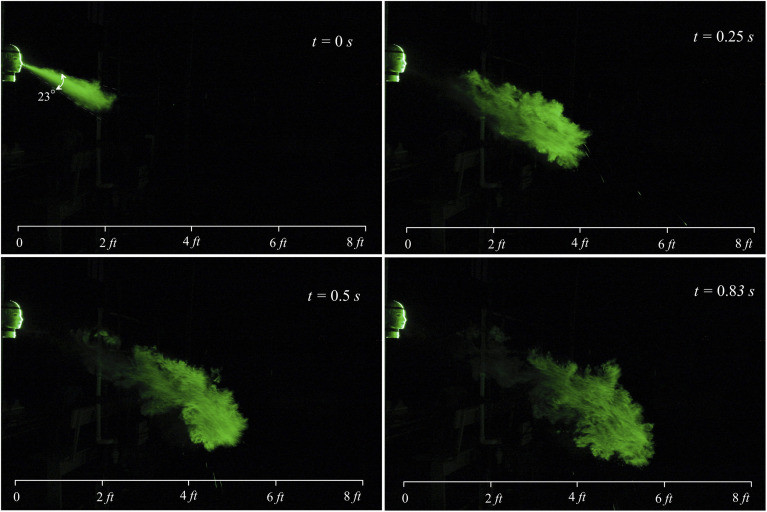 Evolution of a sneeze at Re = 30 000
Evolution of a sneeze at Re = 30 000
The sneeze cloud, much like a turbulent jet, expands in a conical shape with a spreading angle of about 23 degrees. This turbulent nature is crucial because it keeps the smaller droplets suspended in the air for longer, allowing them to travel greater distances. The initial momentum of the sneeze and the entrainment of surrounding air contribute to this extended reach.
The experiment also noted that while larger droplets might fall to the ground sooner, smaller particles can remain airborne and travel the full 25-foot distance. This is particularly important because these smaller aerosolized particles can carry infectious pathogens and pose a risk of airborne transmission.
Mask Effectiveness: A Layered Approach to Protection
Beyond just measuring sneeze distance, the study investigated the effectiveness of various types of face masks and face shields in blocking sneeze droplets. Different masks were tested, ranging from homemade cotton masks to surgical masks and N-95 respirators.
Homemade Masks: Three Layers for Better Defense
The researchers examined homemade masks made from handkerchiefs, both with two and three layers. A two-layered mask did offer some protection, reducing the sneeze travel distance to about 1.5 feet. Adding a third layer of cotton to the homemade mask improved its ability to block particles, although the travel distance remained around 1.5 feet. This suggests that while homemade masks can impede the initial force of a sneeze, some leakage still occurs.
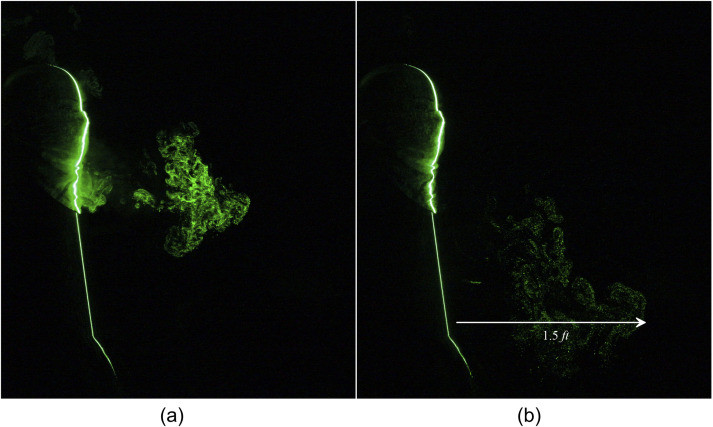 Leakage of a human sneeze from a two-layered triangle mask can travel to 1.5 ft
Leakage of a human sneeze from a two-layered triangle mask can travel to 1.5 ft
Face Shields: Forward Protection, but Gaps Remain
Face shields proved effective in blocking the forward motion of sneeze droplets. However, the study revealed a significant amount of leakage occurring below the face shield. These escaped particles could still travel up to 1 foot. Therefore, a face shield alone may not be sufficient to prevent the spread of sneeze droplets. Combining a face shield with a two-layered mask improved forward protection, but downward leakage, reaching about 0.5 feet, was still observed.
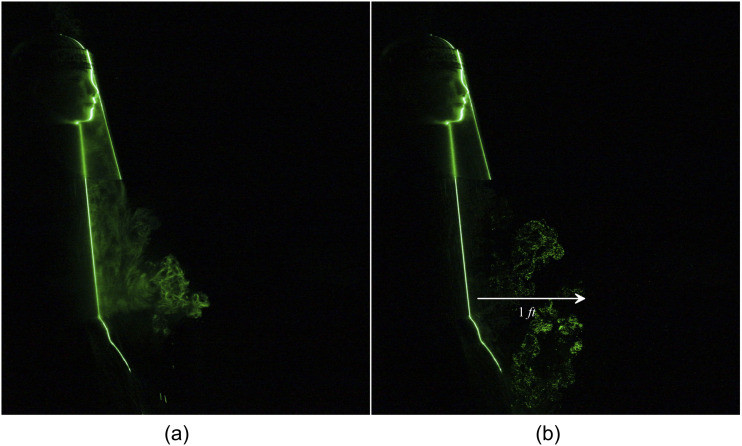 Escaped particles from a plastic face shield can travel to 1 ft
Escaped particles from a plastic face shield can travel to 1 ft
Surgical Masks: Surprisingly Less Effective Than Expected
Standard three-layer surgical masks, commonly used for protection, showed a surprising result. They were found to be less effective than homemade three-layer cotton masks in blocking sneeze droplets. Particles leaked from surgical masks traveled as far as 2.5 feet. Even when combined with a face shield, surgical masks still allowed downward leakage of about 0.4 feet. This highlights that surgical masks, while offering some barrier, may not be the optimal choice for containing a forceful sneeze.
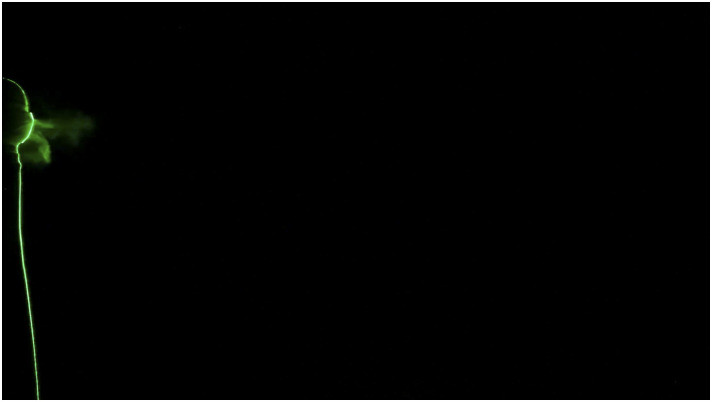 Leakage of tracer particles from a surgical mask
Leakage of tracer particles from a surgical mask
N-95 Masks: Forward Blockage, but Backward Leakage
N-95 respirators, known for their high filtration efficiency, lived up to their reputation by completely blocking sneeze droplets in the forward direction. However, the study uncovered a different challenge with N-95 masks: leakage from the sides and top, particularly around the nose area. These leaked particles could travel up to 2 feet in the backward direction. This backward leakage suggests that even with a highly protective mask like an N-95, proper fit and awareness of potential leakage points are crucial.
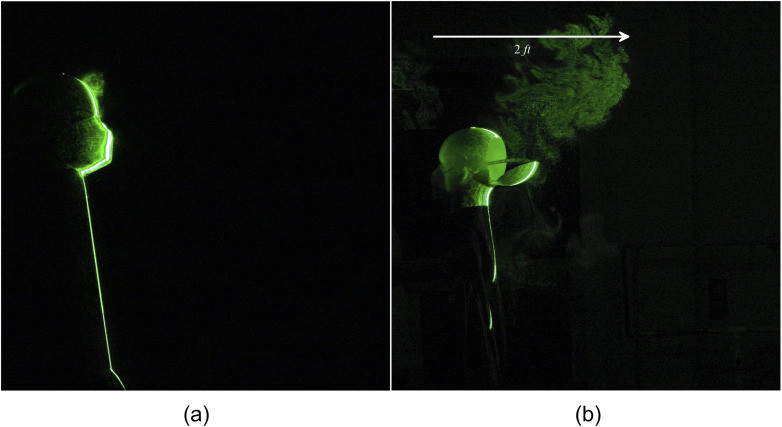 Leakage of human sneeze in the forward direction from an N-95 mask. Significant leakage in the backside and upward direction, which travels up to 2 ft
Leakage of human sneeze in the forward direction from an N-95 mask. Significant leakage in the backside and upward direction, which travels up to 2 ft
Rethinking Social Distancing and Protection Measures
The findings of this study have significant implications for public health guidelines and personal protection practices. The fact that a sneeze can travel up to 25 feet underscores the potential inadequacy of the 6-foot social distancing rule, especially in environments where sneezing might occur.
The study’s mask effectiveness analysis provides valuable insights for choosing appropriate face coverings. Homemade three-layer cotton masks appear to offer better protection than surgical masks against sneeze droplets. While N-95 masks block forward motion, leakage issues highlight the importance of proper fit and additional precautions.
Key Recommendations:
- Reconsider Social Distancing: The 6-foot guideline may not be sufficient, especially considering the potential reach of a sneeze. Maintaining a greater distance, when possible, is advisable.
- Layer Up for Homemade Masks: When using homemade masks, opt for at least three layers of cotton fabric for enhanced protection.
- Face Shields with Masks: Face shields can add an extra layer of protection, but they should be used in conjunction with masks to address leakage issues.
- N-95 Awareness: While N-95 masks are highly effective, be mindful of potential leakage from the sides and top. Proper fit is crucial.
- Elbow or Hand Sneeze Etiquette: Even when wearing a mask, it remains important to cover sneezes and coughs with an elbow or hand to minimize droplet spread, especially considering potential mask leakage.
- Environmental Hygiene: Regularly sanitize surfaces, especially in public spaces, as sneeze droplets can settle on objects even when masks are worn.
- Immediate Evacuation: If someone sneezes nearby, it’s prudent to move away from the area promptly to minimize potential exposure.
Conclusion: Beyond 6 Feet and Basic Masks
This study provides compelling visual evidence of how far a sneeze can travel and a comparative analysis of mask effectiveness. It challenges the conventional 6-foot social distancing rule and offers valuable insights into choosing and using face masks for better protection. Understanding the dynamics of sneeze travel and the limitations of different face coverings is crucial for making informed decisions to protect ourselves and others from the spread of respiratory illnesses. By adopting a more comprehensive approach that combines adequate social distancing, appropriate mask usage, and good hygiene practices, we can more effectively mitigate the risks associated with sneezes and the potential transmission of pathogens.

